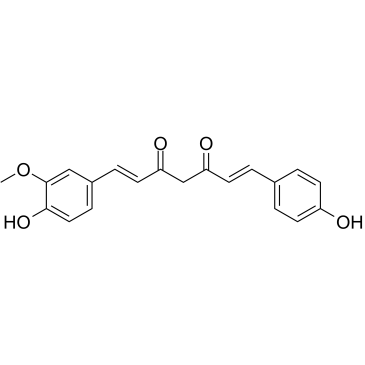demethoxycurcumin

demethoxycurcumin structure
|
Common Name | demethoxycurcumin | ||
|---|---|---|---|---|
| CAS Number | 24939-17-1 | Molecular Weight | 338.354 | |
| Density | 1.3±0.1 g/cm3 | Boiling Point | 571.4±50.0 °C at 760 mmHg | |
| Molecular Formula | C20H18O5 | Melting Point | N/A | |
| MSDS | N/A | Flash Point | 205.5±23.6 °C | |
|
Therapeutic potential of turmeric in Alzheimer's disease: curcumin or curcuminoids?
Phytother Res. 28(4) , 517-25, (2014) Alzheimer's disease (AD) is the most common form of dementia. There is limited choice in modern therapeutics, and drugs available have limited success with multiple side effects in addition to high cost. Hence, newer and alternate treatment options are being ... |
|
|
Differential cellular uptake and metabolism of curcuminoids in monocytes/macrophages: regulatory effects on lipid accumulation.
Br. J. Nutr. 112(1) , 8-14, (2014) We have previously shown that curcumin (CUR) may increase lipid accumulation in cultured human acute monocytic leukaemia cell line THP-1 monocytes/macrophages, but that tetrahydrocurcumin (THC), an in vivo metabolite of CUR, has no such effect. In the present... |
|
|
Demethoxycurcumin, a major active curcuminoid from Curcuma longa, suppresses balloon injury induced vascular smooth muscle cell migration and neointima formation: an in vitro and in vivo study.
Mol. Nutr. Food. Res. 57(9) , 1586-97, (2013) Curcumin has been shown to affect platelet-derived growth factor (PDGF)- and tumor necrosis factor (TNF)-α-elicited vascular smooth muscle cell (VSMC) migration and inhibit neointima formation following vascular injury. However, whether two other curcuminoids... |
|
|
Curcuminoid analogs inhibit nitric oxide production from LPS-activated microglial cells.
J. Nat. Med. 66(2) , 400-5, (2012) The chemically modified analogs, the demethylated analogs 4-6, the tetrahydro analogs 7-9 and the hexahydro analogs 10-12, of curcumin (1), demethoxycurcumin (2) and bisdemethoxycurcumin (3) were evaluated for their inhibitory activity on lipopolysaccharide a... |
|
|
Anti-Acanthamoebic properties of resveratrol and demethoxycurcumin.
Exp. Parasitol. 132(4) , 519-23, (2012) Acanthamoeba is an opportunist protist pathogen that is known to infect the cornea to produce eye keratitis and the central nervous system to produce fatal granulomatous encephalitis. Early diagnosis, followed by aggressive treatment using a combination of dr... |
|
|
A novel approach to active compounds identification based on support vector regression model and mean impact value.
Chem. Biol. Drug Des. 81(5) , 650-7, (2013) Traditionally, active compounds were discovered from natural product extracts by bioassay-guided fractionation, which was with high cost and low efficiency. A well-trained support vector regression model based on mean impact value was used to identify lead ac... |
|
|
Bioactivity of turmeric-derived curcuminoids and related metabolites in breast cancer.
Curr. Pharm. Des. 19(34) , 6218-25, (2013) While the chemotherapeutic effect of curcumin, one of three major curcuminoids derived from turmeric, has been reported, largely unexplored are the effects of complex turmeric extracts more analogous to traditional medicinal preparations, as well as the relat... |
|
|
Concurrent inhibition of enzymatic activity and NF-Y-mediated transcription of Topoisomerase-IIα by bis-DemethoxyCurcumin in cancer cells.
Cell Death Dis. 4 , e756, (2013) Topoisomerases-IIα (TOP2A) enzyme is essential for cell viability due to its fundamental role in DNA metabolism and in chromatin organization during interphase and mitosis. TOP2A expression is finely regulated at the transcriptional level through the binding ... |
|
|
Simultaneous determination of threeCurcuminoidsinCurcuma wenyujin Y.H.chen et C.Ling. by liquid chromatography–tandem mass spectrometry combined with pressurized liquid extraction
J. Pharm. Biomed. Anal. 81-82 , 146-50, (2013) A method based on pressurized liquid extraction (PLE) followed by determination with liquid chromatography–tandem mass spectrometry (LC–MS/MS) was developed for identification and quantification of Curcumin, Demethoxycurcumin and Bisdemethoxycurcumin in Curcu... |
|
|
Bisdemethoxycurcumin protects endothelial cells against t-BHP-induced cell damage by regulating the phosphorylation level of ERK1/2 and Akt.
Int. J. Mol. Med. 27(2) , 205-11, (2011) Curcuminoids are the major active components extracted from Curcuma longa and are well known for their antioxidant effects. Previous studies have reported that the antioxidant properties of curcuminoids are mainly attributed to their free radical scavenging a... |